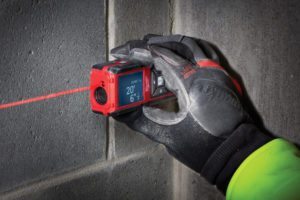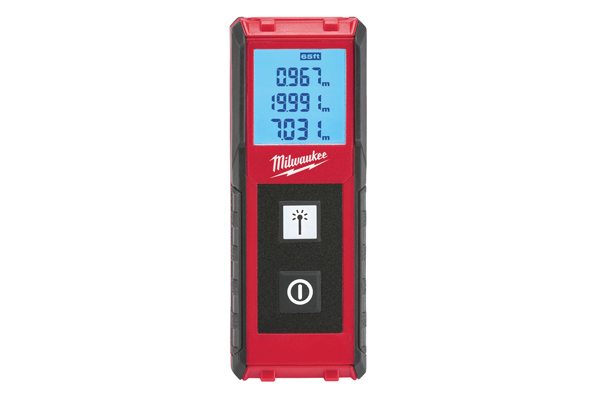
Laser Measuring Tools: Going the Distance
Laser distance measuring tools have come a long way, and the industry isn’t slowing down.
By Peter Fabris
Laser measuring tools – a new product category – has gained new customers in the contracting, architecture and real estate professions during the last few years. When these laser mesuring devices first came to the market about a decade ago, they had drawbacks that limited their utility. Recent product refinements, however, have addressed most of these issues.
New versions of these distance measuring tools tools are easier to use and more durable, and they are available on the market at much lower prices than when first introduced. As a result, contractors today are more likely to give laser measuring tools a try. As the pool of potential users becomes familiar with the benefits and functions they offer, laser measuring tools may become as popular as the trusty measuring tape.
How do Laser Measuring Tools work

Laser distance meters are recommended for measuring distances from about 2 to longer than 300 feet. When the user points the device at a surface in the distance, the tool emits a laser that bounces off the surface. The device calculates the distance the laser travels. Manufacturers say the measurements are accurate to 1⁄16 of an inch. Many users have found the devices to be easier and faster to use than tape measures for almost all measuring tasks, save for short distances of 2 feet or shorter. (For short lengths, a tape measure is just as quick and effective.)
“Laser measuring products have come a long way,” says Annika Ensrud, business unit manager, measuring systems, Hilti. “The first models were expensive and somewhat fragile.”
A dropped unit might become inaccurate or fail to work at all. Today’s models, though, are built to withstand drops from at least the height of a tripod, she says. You don’t have to worry if a gust of wind knocks over a stand holding a meter.
Prices decreased, too. Some basic laser measuring tool models now cost less than $50, and higher end products with multiple bells and whistles can cost more than $300.
Multi-functionality
Laser measuring tools can do more than measure the distance between points A and B. They make it a lot easier, for example, to measure floor-to-ceiling room dimensions. Whereas two people are needed to measure that dimension with a tape measure (one standing on a ladder to hold the end to the ceiling, and another holding the tape to the floor), only one person is needed with a laser device. You simply hold the tool against the wall from any height, and the device measures two distances: up to the ceiling, and down to the floor. Then the device automatically adds the two figures together to reveal the floor-to-ceiling dimension. It’s a near instantaneous process.
Many laser distance measuring tools models also offer built-in formulas that calculate room square footage and volume. These features make determining amounts of materials easier. Tasks like calculating how much flooring material is needed for a given space, how much paint is needed for a room, or what capacity of HVAC equipment is needed for a house become much easier than if done with an old tape measuring and paper-and-pencil method. Some models hold these measurements in memory for weeks. Some higher end laser models allow users to export measurements to other electronic devices wirelessly, and then to import the calculations to digital construction documents.
 While the basic functionality of all models is the same, features among manufacturers vary considerably, even between models. This is true in the appearance of the laser itself. In the past, all devices emitted red lasers. Today, some models use green. “Green lasers are four times more visible to the human eye,” Ensrud says. While they show up better outdoors or in bright rooms, they also are pricier.
While the basic functionality of all models is the same, features among manufacturers vary considerably, even between models. This is true in the appearance of the laser itself. In the past, all devices emitted red lasers. Today, some models use green. “Green lasers are four times more visible to the human eye,” Ensrud says. While they show up better outdoors or in bright rooms, they also are pricier.
Improved usability
The user interface varies from device to device, but in general, manufacturers have made laser measuring tools more intuitive in recent years. “The biggest improvement recently has been in ease of use,” says Derek Rose, product manager for Milwaukee Tools. Like many companies, Milwaukee has refined interfaces based on user feedback.
“Users told us that they were not intuitive and could be kind of clunky to navigate,” Rose says. “Our new products are straightforward. They walk you through the functions step by step. You don’t need to follow a manual.”
For example, short phrases now accompany icons that represent different functions. Previously, without the written explanations, many users weren’t sure what the icons represented without consulting a manual.
Some laser measuring tools on the market today guide users through the steps to accomplish a particular task. Still, to get the most out of a laser meter, the user should spend some time playing around with the functions to become familiar with what it can do, says Rose.
Recent Laser Measuring Tool innovations
New high-end models offer some innovative features. For example, some of Hilti’s recent offerings use rotating lasers that project a plane of multiple lines. This can be used to visualize the spacing to lay out wall studs, drop ceilings, or pipes. Some new models also are equipped with cameras.
 “This helps with distant shots, because you can zoom in to where you are bouncing the laser to make sure long distance measurements are accurate,” Ensrud says. You can also take pictures of what you are measuring, making it easier to remember what the dimensions represent.
“This helps with distant shots, because you can zoom in to where you are bouncing the laser to make sure long distance measurements are accurate,” Ensrud says. You can also take pictures of what you are measuring, making it easier to remember what the dimensions represent.
Bosch has added Bluetooth functionality to some of its models, making it easier to share measurements wirelessly among mobile phones and tablets.
No matter the model chosen, a new user will want to invest some time using it in the field to gain trust in the device. Many new users tend to double check the accuracy of measurements with a long tape measure, and tape measures still can provide comfort for certain applications. “Users understand that a laser is more accurate, but you can’t see the increments on the laser like you can on a tape measure,” says Brandon Eble, product manager, laser measuring, Bosch.
Hang on to your tape measure
On rare occasions, laser meters won’t be able to perform the needed function. “You need to have something to bounce the laser off of,” Rose explains. “If you’re measuring at a wide-open job site, you’ll need to use a measuring wheel or a long tape.”
While laser meters can accomplish a lot, it’s not likely that they will completely replace tape measures, although their cousins, laser levels, have “obsoleted the bubble level,” says Eble. (It’s worth noting that many laser meters also have leveling functionality.)
“You’ll still always see a traditional measuring tool for certain types of applications,” Ensrud says. Measuring short distances will still be performed the old fashioned way, and it’s wise to retain longer tape measures as backups to laser meters even if you come to rely on the new tools. After all, if batteries die on a laser meter, the device won’t work. So, it’s also a good idea to keep spare batteries – most laser tools use standard AA cells – on hand.
Considering all the functions performed at current prices, you don’t need psychic powers to foresee a day when most contractors will keep a laser meter in their tool belt. As fairly new products, these distance measuring tools will continue to be refined and improved so that they can do more and be easier to use. Eble estimates that about one-quarter of the contracting market has already adopted laser measuring tools and that percentage is growing robustly. The future for laser meters seems as bright as the lights they emit.

